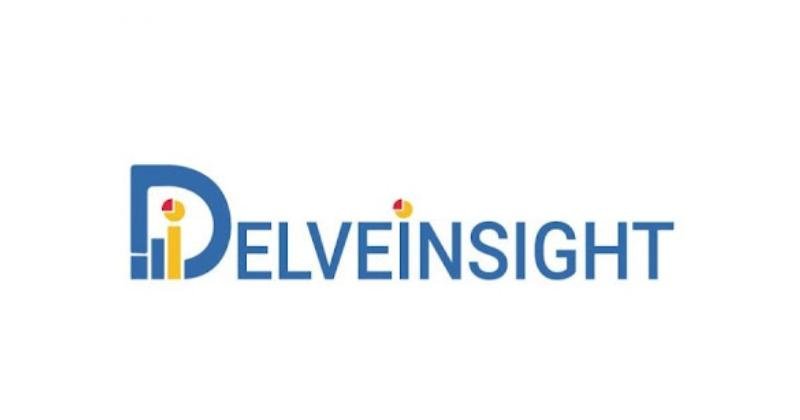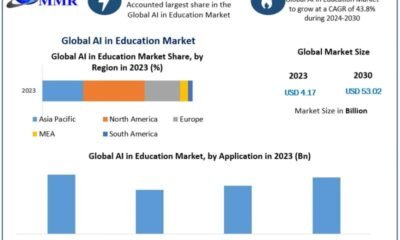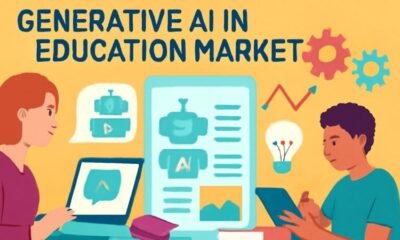AI Research
Global Artificial Intelligence (AI) in Diagnostics Market

According to DelveInsight’s analysis, The increasing incidence of infectious and chronic diseases is fueling the need for early and accurate diagnosis, where Artificial Intelligence plays a crucial role by improving detection and enabling quicker clinical decisions. At the same time, the widespread adoption of digital health and imaging technologies is creating a robust platform for incorporating AI solutions into current healthcare systems, enhancing both efficiency and accuracy. Moreover, the surge in product development efforts by leading Artificial Intelligence in Diagnostics companies worldwide, supported by advancements in machine learning and favorable regulatory frameworks, is broadening access to AI-driven diagnostic tools. Collectively, these factors are anticipated to drive substantial growth in the global Artificial Intelligence in Diagnostics market, facilitating more precise, timely, and scalable healthcare solutions during the 2025 to 2032 forecast period.
DelveInsight’s “Artificial Intelligence (AI) in Diagnostics Market Insights, Competitive Landscape and Market Forecast-2032” report provides the current and forecast market outlook, forthcoming device innovation, challenges, market drivers and barriers. The report also covers the major emerging products and key Artificial Intelligence (AI) in Diagnostics companies actively working in the market.
To know more about why North America is leading the market growth in the Artificial Intelligence (AI) in Diagnostics market, get a snapshot of the report Artificial Intelligence (AI) in Diagnostics Market Trends
https://www.delveinsight.com/sample-request/ai-in-diagnostics-market?utm_source=openpr&utm_medium=pressrelease&utm_campaign=gpr
Artificial Intelligence (AI) in Diagnostics Overview
Artificial Intelligence (AI) in Diagnostics, also known as ear tubes or grommets, are small cylindrical devices inserted into the eardrum to allow air to enter the middle ear and prevent fluid buildup. They are commonly used to treat recurrent ear infections (otitis media) or persistent middle ear fluid (effusion) in children and adults. Artificial Intelligence (AI) in Diagnostics help improve hearing, reduce the risk of infection, and relieve pressure or pain caused by fluid accumulation. The procedure to insert these tubes is called myringotomy and is typically quick and minimally invasive. The tubes often fall out on their own within 6 to 18 months.
DelveInsight Analysis: The AI in Diagnostics market, valued at USD 1,623.20 million in 2024, is projected to expand at a compound annual growth rate (CAGR) of 22.31% from 2025 to 2032, reaching an estimated USD 8,081.97 million by 2032.
Artificial Intelligence (AI) in Diagnostics Market Insights
Geographically, North America is expected to hold the largest share of the AI in Diagnostics market in 2024. This leading position is driven by several critical factors, such as the growing incidence of chronic and infectious diseases, widespread adoption of imaging technologies, strong research and development (R&D) activities, a well-developed healthcare infrastructure, and a supportive regulatory framework that facilitates product approvals and market entry.
To read more about the latest highlights related to Artificial Intelligence (AI) in Diagnostics, get a snapshot of the key highlights entailed in the Artificial Intelligence (AI) in Diagnostics
https://www.delveinsight.com/report-store/ai-in-diagnostics-market?utm_source=openpr&utm_medium=pressrelease&utm_campaign=gpr
Recent Developments in the Artificial Intelligence (AI) in Diagnostics Market Report
• In April 2025, Roche has revealed that the U.S. Food and Drug Administration (FDA) has awarded Breakthrough Device Designation to its VENTANA® TROP2 (EPR20043) RxDx Device. This represents the first time a computational pathology companion diagnostic (CDx) device has received this designation.
• In April 2025, Avant Technologies, Inc., along with its joint venture partner Ainnova Tech, Inc., announced that the U.S. Food and Drug Administration (FDA) is currently reviewing their submission package for a pre-submission meeting focused on Avant’s VisionAI platform. This AI-driven technology is designed to transform the early detection of diseases through advanced artificial intelligence solutions.
• In April 2025, Proprio announced that its Paradigm AI surgical guidance platform has received FDA 510(k) clearance to incorporate intraoperative measurements, marking the first time surgeons can access real-time, 3D, dynamic, and segmental anatomical visualization and measurement during procedures.
• In September 2024, Ibex Medical Analytics (Ibex), a leading company in AI-based cancer diagnostics, unveiled the latest enhancements to its Ibex-AI platform. Developed in partnership with experienced pathologists across the globe who regularly utilize the platform in clinical practice, these updates reflect Ibex’s dedication to delivering advanced diagnostic solutions designed to support healthcare professionals directly involved in patient care.
• In October 2023, Lucida Medical Ltd announced that its AI-driven prostate cancer detection software, Prostate IntelligenceTM (PiTM), has been awarded Class IIb CE certification. Utilizing advanced AI technology, PiTM analyzes MRI scans and integrates smoothly into the radiologist’s workflow.
• In March 2023, Qritive has introduced its newest AI-powered solution, QAi Prostate, developed to enhance prostate cancer diagnosis. The platform uses advanced machine learning algorithms to accurately analyze whole slide images of prostate core needle biopsies.
• Thus, owing to such developments in the market, rapid growth will be observed in the Artificial Intelligence (AI) in Diagnostics market during the forecast period
Key Players in the Artificial Intelligence (AI) in Diagnostics Market
Some of the key market players operating in the Artificial Intelligence (AI) in Diagnostics market include- Aidoc, Owkin, Inc., Siemens Healthineers, PathAI, Ibex, Owkin, Inc., Imagen Technologies, Aiforia, RADLogics, Terarecon, Inc., Prenosis, Inc., Ibex, Google LLC, GE HealthCare, DreaMed, Riverain Technologies, Terarecon, Inc., Aiforia, RADLogics, and others.
Which MedTech key players in the Artificial Intelligence (AI) in Diagnostics market are set to emerge as the trendsetter explore @ Key Artificial Intelligence (AI) in Diagnostics Companies
https://www.delveinsight.com/sample-request/ai-in-diagnostics-market?utm_source=openpr&utm_medium=pressrelease&utm_campaign=gpr
Analysis on the Artificial Intelligence (AI) in Diagnostics Market Landscape
As reported by the British Heart Foundation (2025), approximately 640 million people worldwide are living with heart and circulatory diseases. These conditions require early and accurate diagnosis, as timely detection significantly improves patient outcomes and reduces mortality. Artificial Intelligence (AI) tools are increasingly being adopted in diagnostic workflows to analyze medical images such as CT scans, MRIs, and echocardiograms, offering greater precision and efficiency compared to conventional methods, thereby driving growth in the Artificial Intelligence in Diagnostics market.
Moreover, the expanding use of digital health solutions and advanced imaging technologies is further propelling the AI diagnostics market by enhancing the speed, accuracy, and accessibility of diagnostic processes. AI-powered algorithms can effectively interpret complex imaging data, facilitating early diagnosis in key areas such as oncology, cardiology, and pulmonology. For example, in December 2024, GE HealthCare unveiled its Sonic DL AI MRI algorithm at the RSNA 2024 conference. This innovation accelerates MRI scans by up to 86% while improving image clarity for brain, spine, orthopedic, and body imaging applications. Collectively, these factors are anticipated to drive significant growth in the global Artificial Intelligence in Diagnostics market.
Scope of the Artificial Intelligence (AI) in Diagnostics Market Report
• Coverage: Global
• Study Period: 2022-2032
• Artificial Intelligence (AI) in Diagnostics Market Segmentation By Product Type: Hardware/software, and Services
• Artificial Intelligence (AI) in Diagnostics Market Segmentation By Application Type: Infectious Disease Diagnostics, Radiology, Oncology, Cardiology, and others
• Artificial Intelligence (AI) in Diagnostics Market Segmentation By Technology Type: (Machine Learning, Natural Language Processing, and Others
• Artificial Intelligence (AI) in Diagnostics Market Segmentation By Geography: North America, Europe, Asia-Pacific, and Rest of the World
• Key Artificial Intelligence (AI) in Diagnostics Companies: Aidoc, Owkin, Inc., Siemens Healthineers, PathAI, Ibex, Owkin, Inc., Imagen Technologies, Aiforia, RADLogics, Terarecon, Inc., Prenosis, Inc., Ibex, Google LLC, GE HealthCare, DreaMed, Riverain Technologies, Terarecon, Inc., Aiforia, RADLogics, and others
• Porter’s Five Forces Analysis, Product Profiles, Case Studies, KOL’s Views, Analyst’s View
Interested in knowing how the Artificial Intelligence (AI) in Diagnostics market will grow by 2032? Click to get a snapshot of the Artificial Intelligence (AI) in Diagnostics Market Analysis
https://www.delveinsight.com/sample-request/ai-in-diagnostics-market?utm_source=openpr&utm_medium=pressrelease&utm_campaign=gpr
Table of Contents
1 Artificial Intelligence (AI) in Diagnostics Market Report Introduction
2 Artificial Intelligence (AI) in Diagnostics Market Executive summary
3 Regulatory and Patent Analysis
4 Artificial Intelligence (AI) in Diagnostics Market Key Factors Analysis
5 Porter’s Five Forces Analysis
6 COVID-19 Impact Analysis on Artificial Intelligence (AI) in Diagnostics Market
7 Artificial Intelligence (AI) in Diagnostics Market Layout
8 Global Company Share Analysis – Key Artificial Intelligence (AI) in Diagnostics Companies
9 Company and Product Profiles
10 Project Approach
11 Artificial Intelligence (AI) in Diagnostics Market Drivers
12 Artificial Intelligence (AI) in Diagnostics Market Barriers
13 About DelveInsight
Latest Reports by DelveInsight
• Transdermal Drug Delivery Devices: https://www.delveinsight.com/report-store/transdermal-drug-delivery-devices-market
• Infusion Pumps Market: https://www.delveinsight.com/report-store/infusion-pumps-market
• Acute Radiation Syndrome Market: https://www.delveinsight.com/report-store/acute-radiation-syndrome-pipeline-insight
• Human Papillomavirus Hpv Market: https://www.delveinsight.com/report-store/human-papillomavirus-hpv-market
• Blood Gas And Electrolyte Analyzers Market: https://www.delveinsight.com/report-store/blood-gas-and-electrolyte-analyzers-market
• Interspinous Spacers Market: https://www.delveinsight.com/report-store/interspinous-spacers-market
• Dengue Fever Market: https://www.delveinsight.com/report-store/dengue-fever-market
Contact Us
Gaurav Bora
info@delveinsight.com
+14699457679
www.delveinsight.com
About DelveInsight
DelveInsight is a leading Business Consultant and Market Research firm focused exclusively on life sciences. It supports Pharma companies by providing end-to-end comprehensive solutions to improve their performance.
Get hassle-free access to all the healthcare and pharma market research reports through our subscription-based platform PharmDelve.
This release was published on openPR.
AI Research
(Policy Address 2025) HK earmarks HK$3B for AI research and talent recruitment – The Standard (HK)
AI Research
[2506.08171] Worst-Case Symbolic Constraints Analysis and Generalisation with Large Language Models

View a PDF of the paper titled Worst-Case Symbolic Constraints Analysis and Generalisation with Large Language Models, by Daniel Koh and 4 other authors
Abstract:Large language models (LLMs) have demonstrated strong performance on coding tasks such as generation, completion and repair, but their ability to handle complex symbolic reasoning over code still remains underexplored. We introduce the task of worst-case symbolic constraints analysis, which requires inferring the symbolic constraints that characterise worst-case program executions; these constraints can be solved to obtain inputs that expose performance bottlenecks or denial-of-service vulnerabilities in software systems. We show that even state-of-the-art LLMs (e.g., GPT-5) struggle when applied directly on this task. To address this challenge, we propose WARP, an innovative neurosymbolic approach that computes worst-case constraints on smaller concrete input sizes using existing program analysis tools, and then leverages LLMs to generalise these constraints to larger input sizes. Concretely, WARP comprises: (1) an incremental strategy for LLM-based worst-case reasoning, (2) a solver-aligned neurosymbolic framework that integrates reinforcement learning with SMT (Satisfiability Modulo Theories) solving, and (3) a curated dataset of symbolic constraints. Experimental results show that WARP consistently improves performance on worst-case constraint reasoning. Leveraging the curated constraint dataset, we use reinforcement learning to fine-tune a model, WARP-1.0-3B, which significantly outperforms size-matched and even larger baselines. These results demonstrate that incremental constraint reasoning enhances LLMs’ ability to handle symbolic reasoning and highlight the potential for deeper integration between neural learning and formal methods in rigorous program analysis.
Submission history
From: Daniel Koh [view email]
[v1]
Mon, 9 Jun 2025 19:33:30 UTC (1,462 KB)
[v2]
Tue, 16 Sep 2025 10:35:33 UTC (1,871 KB)
AI Research
Spatially-Aware Image Focus for Visual Reasoning

View a PDF of the paper titled SIFThinker: Spatially-Aware Image Focus for Visual Reasoning, by Zhangquan Chen and 6 other authors
Abstract:Current multimodal large language models (MLLMs) still face significant challenges in complex visual tasks (e.g., spatial understanding, fine-grained perception). Prior methods have tried to incorporate visual reasoning, however, they fail to leverage attention correction with spatial cues to iteratively refine their focus on prompt-relevant regions. In this paper, we introduce SIFThinker, a spatially-aware “think-with-images” framework that mimics human visual perception. Specifically, SIFThinker enables attention correcting and image region focusing by interleaving depth-enhanced bounding boxes and natural language. Our contributions are twofold: First, we introduce a reverse-expansion-forward-inference strategy that facilitates the generation of interleaved image-text chains of thought for process-level supervision, which in turn leads to the construction of the SIF-50K dataset. Besides, we propose GRPO-SIF, a reinforced training paradigm that integrates depth-informed visual grounding into a unified reasoning pipeline, teaching the model to dynamically correct and focus on prompt-relevant regions. Extensive experiments demonstrate that SIFThinker outperforms state-of-the-art methods in spatial understanding and fine-grained visual perception, while maintaining strong general capabilities, highlighting the effectiveness of our method. Code: this https URL.
Submission history
From: Zhangquan Chen [view email]
[v1]
Fri, 8 Aug 2025 12:26:20 UTC (5,223 KB)
[v2]
Thu, 14 Aug 2025 10:34:22 UTC (5,223 KB)
[v3]
Sun, 24 Aug 2025 13:04:46 UTC (5,223 KB)
[v4]
Tue, 16 Sep 2025 09:40:13 UTC (5,223 KB)
-

 Business3 weeks ago
Business3 weeks agoThe Guardian view on Trump and the Fed: independence is no substitute for accountability | Editorial
-
Tools & Platforms1 month ago
Building Trust in Military AI Starts with Opening the Black Box – War on the Rocks
-

 Ethics & Policy2 months ago
Ethics & Policy2 months agoSDAIA Supports Saudi Arabia’s Leadership in Shaping Global AI Ethics, Policy, and Research – وكالة الأنباء السعودية
-

 Events & Conferences4 months ago
Events & Conferences4 months agoJourney to 1000 models: Scaling Instagram’s recommendation system
-

 Jobs & Careers3 months ago
Jobs & Careers3 months agoMumbai-based Perplexity Alternative Has 60k+ Users Without Funding
-

 Podcasts & Talks2 months ago
Podcasts & Talks2 months agoHappy 4th of July! 🎆 Made with Veo 3 in Gemini
-

 Education2 months ago
Education2 months agoMacron says UK and France have duty to tackle illegal migration ‘with humanity, solidarity and firmness’ – UK politics live | Politics
-

 Education3 months ago
Education3 months agoVEX Robotics launches AI-powered classroom robotics system
-

 Podcasts & Talks2 months ago
Podcasts & Talks2 months agoOpenAI 🤝 @teamganassi
-

 Funding & Business3 months ago
Funding & Business3 months agoKayak and Expedia race to build AI travel agents that turn social posts into itineraries













